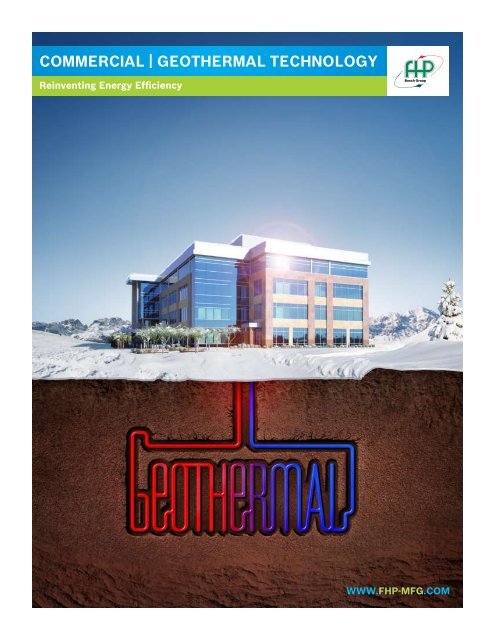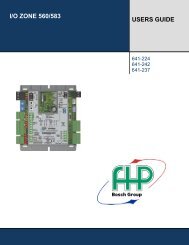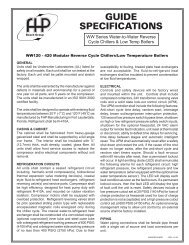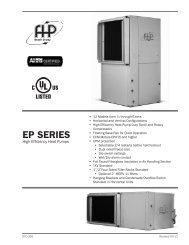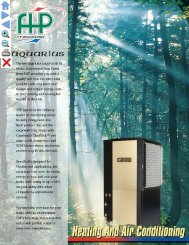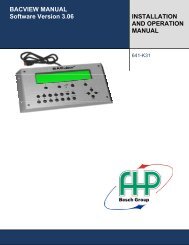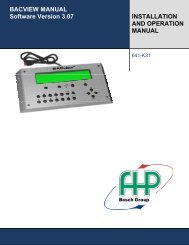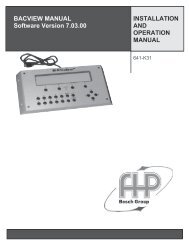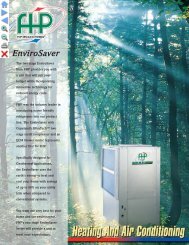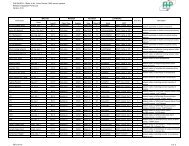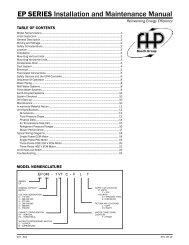CommerCial | GeoTHermal TeCHNoloGY - FHP Manufacturing
CommerCial | GeoTHermal TeCHNoloGY - FHP Manufacturing
CommerCial | GeoTHermal TeCHNoloGY - FHP Manufacturing
Create successful ePaper yourself
Turn your PDF publications into a flip-book with our unique Google optimized e-Paper software.
Commercial | GEOTHERMAL TECHNOLOGY<br />
Reinventing Energy Efficiency<br />
www.fhp-mfg.com
<strong>FHP</strong>’s Geothermal And Water Source Systems<br />
Our Heat Pump systems are the most energy and cost efficient systems on the market and therefore the greenest<br />
technology and the smartest investment for commercial heating and cooling applications.<br />
Geothermal Systems<br />
As the cost of energy increases geothermal installations become the system of choice.<br />
The earth has a tremendous capacity of storing thermal energy which can be utilized to heat or cool a building.<br />
Although the initial cost of a geothermal application may be higher, if one considers the life cycle savings in energy<br />
and the reduced maintenance cost then geothermal is the smartest decision for your project.<br />
Geothermal systems are especially recommended in areas that have significant heating and cooling loads.<br />
In areas that are either cooling or heating dominant our hybrid systems could be the perfect solution for your<br />
needs. Using a cooling tower in conjunction with a ground loop in areas that have a cooling dominant load<br />
reduces the cost of the loop field with only a small impact on the efficiency of the system. Conversely in areas<br />
that are heating dominant the addition of a boiler to a geothermal loop reduces the loop field cost with a minimal<br />
effect on the efficiency of the system.<br />
Water Source Cooling Tower/Boiler Systems<br />
A tower/boiler system offers as excellent alternative to a geothermal system where space is limited or initial costs<br />
are a determinant factor.<br />
The tower/boiler system consists of a cooling tower that will reject heat absorbed by the loop when the system<br />
is predominantly in the cooling mode. The boilers function is to add heat to the loop when there is a net heating<br />
demand. In many instances the heat generated by the units in cooling balance the heat loss in the loop for the units<br />
in the heating mode. In this situation neither the tower nor boiler will operate as the system is self balancing.<br />
Environmental stewardship is a core philosophy for <strong>FHP</strong><br />
<strong>Manufacturing</strong> from design to production to the reduction<br />
in our customers’ energy bills. At <strong>FHP</strong>, we are working on a<br />
better future every day.<br />
1 | <strong>FHP</strong> | Bosch Group | Heat Pumps | Commercial | Geothermal Technology
Advantages Of <strong>FHP</strong>’s Technology<br />
Low Installation Costs<br />
<strong>FHP</strong> water source heat pumps systems provide the most flexible and lowest installation costs of virtually any<br />
HVAC system. In a typical installation the water loop remains above the dew point of the ambient air meaning no<br />
insulation is required on piping, a major cost of any installation. To accomplish the same degree of flexibility as a<br />
heat pump system a four pipe system is required. This represents another significant cost saving potential since<br />
heat pumps installations only require a two pipe system for either heating or cooling.<br />
Flexibility and Comfort<br />
<strong>FHP</strong> units come in a wide variety of models, sizes and configurations. This provides the design engineer true<br />
flexibility when designing the system. Should the occupancy of an area change the unit may be changed out for<br />
the appropriate size without major modifications to the layout.<br />
Energy Efficient<br />
<strong>FHP</strong> units operate individually with high efficiency making the complete system extremely efficient. What makes<br />
this system unique is the ability to transfer heat around the building in winter through the common water loop.<br />
In today’s modern buildings, interior zones generally require cooling even in the winter because of the lighting,<br />
occupancy and electronic loading. When cooling these areas heat is transferred to the water loop and utilized by<br />
the units on the perimeter that may require heating. This is the only system with this capability and the net result<br />
is a truly economical operating system. Individual units serve specific zones so that there is no need to operate<br />
large units if there is only a small area calling for heating or cooling.<br />
Redundancy<br />
The building is not dependent on one or two large chillers. With multiple units serving individual zones should<br />
one unit fail, only this area is affected. <strong>FHP</strong> units are designed for convenient, easy and fast service and do not<br />
require specialized training to maintain or repair. Downtime should be minimal. Routine maintenance is limited<br />
to filter replacement and an annual checkup making maintenance cost for water source heat pumps one of the<br />
lowest of any system.<br />
Space Savings<br />
<strong>FHP</strong> horizontal units are designed to be as compact as possible. In a commercial application units are typically<br />
located above a false ceiling meaning that large equipment rooms that would normally house large chillers or air<br />
handlers are not required. This frees up space that can now be used for tenant occupancy generating additional<br />
revenue throughout the life of the building.<br />
Each <strong>FHP</strong> unit will have its own duct system to serve the specific zone. Large central plant ducting is not required<br />
allowing for the possibility of reduced floor to floor height with a corresponding reduction in the mass and cost<br />
of the building.<br />
<strong>FHP</strong> | Bosch Group | Heat Pumps | Commercial | Geothermal Technology | 2
Operation Modes Of A Heat Pump<br />
Cooling Mode<br />
Supply Water<br />
From Thermal Source<br />
Return Air<br />
Thermal Expansion Valve<br />
Water-To-Refrigerant<br />
Heat Exchanger<br />
Compressor<br />
Blower<br />
Hot Gas<br />
Reversing<br />
Valve<br />
Air-To-Refrigerant<br />
Heat Exchanger Coil<br />
Return Water<br />
To Thermal Source<br />
Suction Line<br />
In the COOLING mode, the refrigerant, a hot<br />
gas, is pumped from the compressor to the<br />
water-to-refrigerant heat exchanger via the<br />
reversing valve.<br />
Water, generally with an anti freeze, flowing<br />
through the water-to-refrigerant heat exchanger<br />
removes heat and the hot gas condenses into a<br />
liquid. This liquid then flows through a metering<br />
device to the air-to-refrigerant heat exchanger<br />
coil. In evaporating into a gas, the liquid absorbs<br />
heat and cools and dehumidifies the air that<br />
passes over the coil surface. The cooling cycle is<br />
completed when the refrigerant flows as a low<br />
pressure gas through the reversing valve and<br />
back to the suction side of the compressor.<br />
3 | <strong>FHP</strong> | Bosch Group | Heat Pumps | Commercial | Geothermal Technology
<strong>FHP</strong> | Bosch Group | Heat Pumps | Commercial | Geothermal Technology | 4
Operation Modes Of A Heat Pump<br />
Heating Mode<br />
Supply Water<br />
From Thermal Source<br />
Return Air<br />
Thermal Expansion Valve<br />
Water-To-Refrigerant<br />
Heat Exchanger<br />
Compressor<br />
Blower<br />
Hot Gas<br />
Reversing<br />
Valve<br />
Air-To-Refrigerant<br />
Heat Exchanger Coil<br />
Return Water<br />
To Thermal Source<br />
Suction Line<br />
During the HEATING mode, the refrigerant, a hot<br />
gas, is pumped from the compressor to the air-torefrigerant<br />
heat exchanger coil via the reversing<br />
valve. In the air-to-refrigerant heat exchanger<br />
coil, the heat is removed by the air that passes<br />
over the coil surface, and the hot gas condenses<br />
into a liquid. The air is circuited to the space and<br />
provides heating for the building. The refrigerant<br />
liquid then flows through a metering system to<br />
the water-to-refrigerant heat exchanger. While it<br />
evaporates into a gas, the liquid absorbs heat and<br />
cools the water. The heating cycle is completed<br />
when the refrigerant flows as a low pressure<br />
gas through the reversing valve and back to the<br />
suction side of the compressor.<br />
5 | <strong>FHP</strong> | Bosch Group | Heat Pumps | Commercial | Geothermal Technology
<strong>FHP</strong> | Bosch Group | Heat Pumps | Commercial | Geothermal Technology | 6
Earth Coupling Options<br />
Geothermal systems use the earth as a heat source and heat sink. In order to transfer heat to or from the house<br />
heat exchangers (ground loops) are installed in the ground. These consist of high density polyethylene plastic<br />
pipes. The loops are then connected to the heat pump and fluid circulated between them transferring the heat<br />
between the heat pump and the earth.<br />
Vertical Ground<br />
Loop System<br />
Horizontal Ground<br />
Loop System<br />
Pond/Lake<br />
Loop System<br />
Well Water<br />
System<br />
7 | <strong>FHP</strong> | Bosch Group | Heat Pumps | Commercial | Geothermal Technology
Vertical Ground Loop System<br />
This type is used mainly in commercial buildings or where space is limited.<br />
Vertical holes 100 to 400 feet deep are drilled in the ground, and a single loop of pipe with a U-tube at the<br />
bottom is installed. The borehole is then sealed with grout to ensure good contact with the soil. The vertical<br />
ground loops are then connected to a horizontal underground header pipe that carries fluid to the unit. The<br />
Earth’s temperature is more stable farther below the surface which is an advantage for the system. Vertical<br />
ground loop fields may be located under buildings or parking lots. The life expectancy is in excess of 50 years.<br />
<strong>FHP</strong> | Bosch Group | Heat Pumps | Commercial | Geothermal Technology | 8
Horizontal Ground Loop System<br />
This type is cost effective on smaller projects or where there is sufficient space for the loop. Trenches, three<br />
to six feet deep are dug in which a series of parallel plastic pipes are laid. These loops are manifolded and<br />
connected to the heat pump. The fluid is then circulated absorbing or rejecting heat to the earth depending<br />
on the mode of operation. A typical horizontal loop will be 400 to 600 feet long for each ton of heating and<br />
cooling but will vary according to the soil type and the layout of the piping.<br />
9 | <strong>FHP</strong> | Bosch Group | Heat Pumps | Commercial | Geothermal Technology
Pond/Lake Loop System<br />
This type of design is economical when a project is located near a body of water. Fluid circulates through<br />
polyethylene piping in a closed system, just as it does through ground loops but in this case underwater.<br />
The pipes may be coiled in a slinky to fit more surfaces into a given amount of space. The lake needs to be a<br />
minimum size and depth depending on the load. Lake loops have no adverse impact on the aquatic system.<br />
<strong>FHP</strong> | Bosch Group | Heat Pumps | Commercial | Geothermal Technology | 10
Well Water System<br />
This type of installation is only possible if there is sufficient ground water available in a well, a lake or river in the<br />
area. The water must be of good quality. Local codes may limit the use of this system in certain areas.<br />
The system is open which means that water is pumped directly into the geothermal unit and then discharged<br />
either into a return well or a body of water. The water quality is unaffected other than a change in the temperature.<br />
11 | <strong>FHP</strong> | Bosch Group | Heat Pumps | Commercial | Geothermal Technology
How To Benefit From Geothermal Heat Pumps<br />
Heating In The Winter<br />
Groundwater or a fluid circulating inside a sealed piping loop absorbs heat from the earth. In the heat pump,<br />
refrigerant is compressed to raise source heat to a higher temperature and heat the air or hot water for<br />
distribution throughout your building.<br />
Cooling In The Summer<br />
The system reverses and expels heat from your building to the cooler earth via the loop system or ground water.<br />
This heat exchange process is not only natural, but is a truly ingenious way to create a comfortable climate in<br />
your building.<br />
Hot Water Year-Round<br />
Plentiful hot water provides added capacity for cafeterias, locker rooms, restrooms, etc. In the summer hot water<br />
is virtually free—produced by the waste heat extracted from interior air during the cooling cycle.<br />
Safety<br />
Geothermal heat pumps have no flame, no flue, no odor and no danger of fumes.<br />
Warranty Protection<br />
Ground loop pipes have warranties of 50+ years.<br />
These systems are dependable, reliable and have a long service life.<br />
<strong>FHP</strong> | Bosch Group | Heat Pumps | Commercial | Geothermal Technology | 12
www.fhp-mfg.com<br />
601 N.W. 65th Court, Ft. Lauderdale, FL 33309<br />
Phone: 954-776-5471 | Fax: 954-776-5529<br />
www.boschtaxcredit.com | www.fhp-mfg.com<br />
970-348


